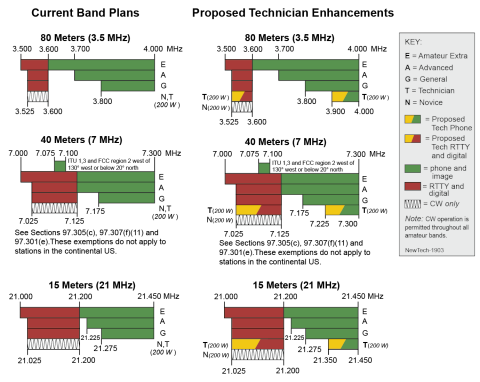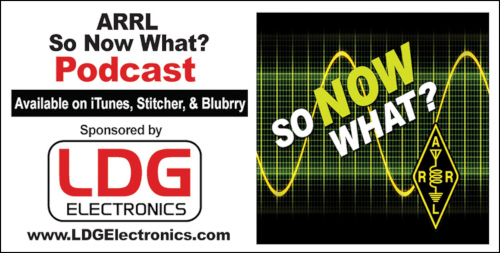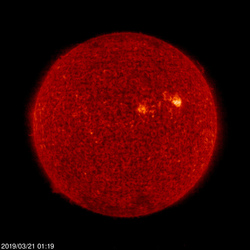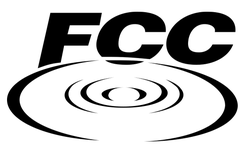 March 21, 2019 John E. Ross, KD8IDJ, Editor
| ||||||
The Two "Entry-Level" Petitions Now Accepting Comments are Very Different The FCC recently invited public comment on ARRL's 2018 Technician Enhancement Petition for Rule Making (RM-11828). It asks the FCC to expand HF privileges for Technician licensees to include limited phone privileges on 75, 40, and 15 meters, plus RTTY and digital mode privileges on 80, 40, 15, and 10 meters. It does not seek to create a new Amateur Radio license class.
The FCC has also invited public comment on an entirely unrelated Petition for Rule Making (RM-11829), filed in 2017 by ARRL member Gary A. Hampton, AD0WU, of Longmont, Colorado. Hampton has asked the FCC to create a new "Tyro" entry-level license class, which would require a minimal online examination as well as mentoring by an Amateur Radio licensee of Technician class or higher. Tyro licensees would have to be at least 11 years old and would earn operating privileges on 99 channels in a 70-centimeter segment that Hampton calls a "TyroSubBand." It would offer no HF privileges. These are not competing petitions. Members of the Amateur Radio community should evaluate both proposals on their own merits and comment if they desire. ARRL has provided a summary of the Technician Enhancement proposals and explained their advantages. Interested parties have 30 days to comment on both proposals. For information on how to file comments, visit "How to Comment on FCC Proceedings." FCC Adopts New Rules for Spectrum above 95 GHz The FCC has adopted new rules to encourage development of new communication technologies and expedite the deployment of new services above 95 GHz. The action was the latest move in the Commission's "Spectrum Horizons" branded initiative. "This spectrum has long been considered the outermost horizon of the usable spectrum range, but rapid advancements in radio technology have made these bands especially ripe for new development," the Prior to its "historic" decision last week, the FCC had no rules for authorizing communication above 95 GHz other than by radio amateurs or through experimental operations. Under current rules, specific Amateur Radio allocations exist at 122.25 - 123.00 GHz; 134 - 141 GHz; 241 - 250 GHz, and at frequencies above 300 GHz, and limited experimentation has taken place in this region of the radio spectrum. Among radio amateurs active in that region of the spectrum is Brian Justin, WA1ZMS, in Virginia -- who has made at least one contact on every available Amateur Radio band. He earned the first-ever ARRL VUCC awards for 122 GHz, 134 GHz, and 241 GHz, and even went so far as to make the first contact on a less-than-1-millimeter band, 322 GHz. In announcing adoption of the new rules for spectrum above 95 GHz, the FCC cited "substantial opportunities for innovation on these frequencies, especially for data-intensive high-bandwidth applications as well as imaging and sensing operations." The new rules create a new "Spectrum Horizons" experimental license for using frequencies between 95 GHz and 3 THz. "These licenses will give innovators the flexibility to conduct experiments lasting up to 10 years, and to more easily market equipment during the experimental period," the FCC said. The FCC action also makes a total of 21.2 GHz of spectrum available for use by unlicensed devices. At the invitation of FCC Chairman Ajit Pai, well-known academic researcher, entrepreneur, contester, and DXer Theodore "Ted" Rappaport, N9NB, delivered remarks prior to the Spectrum Horizons vote. Read more. So Now What? "The New Ham Radio Starter Pack" is the focus of the new (March 21) episode of the "So Now What?" podcast for Amateur Radio newcomers. If you're a newly licensed Amateur Radio operator, chances are you have lots of questions. This biweekly podcast has answers! "So Now What?" offers insights from those who've been just where you are now. New episodes will be posted every other Thursday, alternating new-episode weeks with the "ARRL The Doctor is In" podcast.
ARRL Communications Content Producer Michelle Patnode, W3MVP, and ARRL Station Manager Joe Carcia, NJ1Q, co-host the podcast. Presented as a lively conversation, with Patnode representing newer hams and Carcia the veteran operators, the podcast will explore questions that newer hams may have and the issues that keep participants from staying active in the hobby. Some episodes will feature guests to answer questions on specific topic areas. Listeners can find "So Now What?" on Apple iTunes, Blubrry, Stitcher (free registration required, or browse the site as a guest), and through the free Stitcher app for iOS, Kindle, or Android devices. Episodes will be archived on the ARRL website. Scammers Exploiting Gmail "Dot" Accounts Business technology news website ZDNet reported recently that scammer groups are exploiting so-called Gmail "dot accounts" for online fraud. A lesser-known characteristic of Gmail is that it ignores the dot character within Gmail addresses. "Dots don't matter in Gmail addresses," a Gmail Support response explains. "If someone accidentally adds dots to your address when emailing you, you'll still get that email." Google pointed out, though, that if you use Gmail through work, school, or other organization (such as yourdomain.com or yourschool.edu), dots do change your address. ZDNet says crooks use "dotted" Gmail addresses to file fraudulent claims for unemployment benefits and fake tax returns, and to circumvent trial periods for online services. More recently, someone exploited dotted Gmail accounts to trick Netflix account holders into adding credit card details to scammers' accounts, registered with the user's dotted Gmail address. A legitimate "update your card details" Netflix email would arrive in a real user's inbox, who would then unknowingly update a scammer's account instead of their own. The ZDNet article cited a report from the security firm Agari, which said criminal groups took advantage of dotted Gmail addresses to, among other things, file multiple credit card applications with financial institutions. Crane Hassold, Agari's Senior Director of Threat Research, told ZDNet, "In essence, this allows cybercriminals to centralize their fraudulent activity within a single Gmail account, rather than having to monitor a bunch of different accounts, increasing the efficiency of their operations." Two other Gmail characteristics that scammers could abuse: A Gmail address such as <username>+<randomword>@gmail.com will always redirect emails back to <username>@gmail.com. Also, all emails addressed to <username>@googlemail.com will arrive at <username>@gmail.com. 3Y0I DXpedition Team Has Departed for Bouvet Island The 3Y0I Bouvet Island DXpedition website has announced that the team of operators -- led by Polish DXpeditioner Dom Grzyb, 3Z9DX -- set sail on March 19 from Cape Town, South Africa, for the remote Antarctic island onboard the MV Atlantic Tuna.
According to the website, 3Y0I could be on the air by the end of March, but the team notes that the information is subject to change due to the vagaries of sea and weather conditions. "The team plans to stay at the island at least for 2 weeks, with an option to extend the stay to 3 - 4 weeks, if weather and other factors permit," the announcement said. "We will sign as E51DOM/mm on the way to and back from the island." The DXpedition has enlisted the assistance of noted DXers Martti Laine, OH2BH; Wayne Mills, N7NG, and Yasu Inoue, JR1AIB, to serve "This is a historical undertaking under very severe conditions with no DX Foundation support nor involvement," their announcement said. "One of their objectives is for bringing the cost down to an affordable level for more people." Unlike the unsuccessful 3Y0Z DXpedition, which reached Bouvet Island but was unable to land because of sea conditions and a mechanical problem with the vessel, the 3Y0I operators plan to land using Zodiac inflatable vessels. 3Y0I will attempt to produce a workable signal on 160 and 80 meters in the challenging Bouvet Island environment. The high-volume bands are expected to be 20, 30, and 40 meters. Read more. FCC Cites Amateur Service Rule Violations in Unlicensed Broadcasting Case An FCC Enforcement Bureau Notice of Unlicensed Operation (NoUO) issued last fall to a California Technician-class licensee for alleged unlicensed FM broadcasting on 95.7 MHz has now been upgraded to a Notice of Violation (NoV) that cites violations of the Part 97 Amateur Service rules. The March 15 NoV sent to Daryl Thomas, KE6MWS, of Carmichael, also specifically acknowledges Thomas as an Amateur Radio licensee -- something not done in last November's NoUO. The FCC Enforcement Bureau warned that it could progress to a Notice of Apparent Liability for Forfeiture (NAL), "if warranted."
Last October 10, an Enforcement Bureau agent responded to a complaint of an unlicensed FM station operating on 95.7 MHz in Carmichael. The agent confirmed by direction-finding techniques that a signal on 95.7 MHz was emanating from a residence, and Thomas subsequently admitted that he was the operator of this station, the FCC said in the NoUO. The agent measured the field strength of the signal and found that it exceeded the maximum permitted level of 250 µV per meter at 3 meters, established for unlicensed operation in accordance with FCC Part 15 rules. Despite FCC warnings last fall, the transmissions apparently continued into this year. Just Ahead in Radiosport
See the ARRL Contest Calendar for more information. For in-depth reporting on Amateur Radio contesting, subscribe to The ARRL Contest Update via your ARRL member profile email preferences. The K7RA Solar Update Tad Cook, K7RA, Seattle, reports: Following a month of no sunspots in February, solar activity returned on March 5 - 12, disappeared over 5 days, and returned on March 18 - 20. But our reporting week -- always Thursday through the following Wednesday -- ended with a bang when the daily sunspot number rose to 28 on March 20, the day spring arrived. Sunspot numbers have not been as high since last August. Two sunspot groups are visible -- AR2735 and AR2736.
The solar flux on March 20 was 76.8, higher than any solar flux value since last June. Average daily sunspot numbers declined slightly from 9.9 in the previous 7 days to 8 this week, while the average daily solar flux dipped from 70.9 to 70.7. Average planetary A index rose from 5.1 to 8.1, and average middle latitude A index went from 3.9 to 6.3. Predicted solar flux is 78 on March 21 - 23; 76, 74, and 74 on March 24 - 26; 70 on March 27 - 29; 71 on March 30 - April 9; 70 on April 10; 69 on April 11 - 24; 70 on April 25, and 71 on April 26 - May 4. Predicted planetary A indices are 5 on March 21 - 22; 30, 15, 5, 8, 18, 10, 15, and 8 on March 23 - 30; 5 on March 31 - April 1; 8 on April 2 - 3; 5 on April 4 - 11; 15 on April 12; 5 on April 13 - 15; 10 on April 16; 5 on April 17 - 21; 10, 26, 24, 12, and 8 on April 22 - 26; 5 on April 27 - 28; 8 on April 29 - 30, and 5 on May 1 - 4. Sunspot numbers for March 14 - 20 were 0, 0, 0, 0, 13, 15, and 28, with a mean of 8. The 10.7-centimeter flux was 70.1, 69.6, 69.5, 69.3, 70, 69.7, and 76.8, with a mean of 70.7. Estimated planetary A indices were 7, 7, 12, 16, 3, 7, and 5, with a mean of 8.1. The middle latitude A index was 6, 5, 7, 14, 2, 5, and 5, with a mean of 6.3. A comprehensive K7RA Solar Update is posted Fridays on the ARRL website. For more information concerning radio propagation, visit the ARRL Technical Information Service, read "What the Numbers Mean...," and check out K9LA's Propagation Page. A propagation bulletin archive is available. Monthly charts offer propagation projections between the US and a dozen DX locations. Share your reports and observations. HAARP Gearing Up for its Spring Research Campaign Alaska's High-Frequency Active Auroral Research Program (HAARP) is prepping for its spring research program. The activity will run March 25 - 29. The high-power HF transmitter and huge antenna array located near Gakona, Alaska, is now operated by the University of Alaska Fairbanks (UAF). HAARP Chief Scientist Chris Fallen, KL3WX, said investigations will range from practical to fundamental physical theory.
A "special broadcast" featuring Concordia University Assistant Professor of Intermedia Amanda Dawn Christie will be among the transmissions. Fallen said Christie "has a special 1-hour piece to perform each evening of the campaign at different times." Christie's GHOSTS IN THE AIR GLOW -- ionospheric audio and image mixing with HAARP -- website offers more information. Fallen said HAARP operations will generally occur at times within the windows between 2230 and 0300 UTC, and again between 0500 and 0900 UTC each day. The HAARP spring research program will be Fallen's last, as he will depart UAF for a new position on March 30. Read more. Survey: FT8 Growing as DX Mode in an Era of Waning Propagation In his 2018 update of his survey of modes used on the air, Club Log's Michael Wells, G7VJR, says the number of Club Log users uploading at least one FT8 contact to the site grew from 8,000 in 2017 to 14,200 in 2018. Wells worked with data from Club Log users who, he reports, uploaded 41.3 million contacts in 2018, up by 12% from last year.
He reports that 13,900 users uploaded at least one CW contact, and 18,000 had at least one phone contact. The total number of active users was just under 22,000 across all modes in 2018, Wells said, who added that number has been dropping each year since 2015. "When we look at the graph of QSOs, you can deduce that FT8 users must be prolific in terms of the number of QSOs they make when they're on the air," Wells said. "Once you start making FT8 QSOs, I get the feeling it's more likely you'll be on the bands for longer in a session, as it can be quite addictive working DX in the noise. Having those absolute signal-to-noise figures is compelling." Read more. IARU Represents Amateur Radio at WRC-19 Preparatory Meeting The International Amateur Radio Union (IARU) represented the interests of the Amateur and Amateur-Satellite Services in Geneva at last month's second Conference Preparatory Meeting (CPM) in advance of World Radiocommunication Conference 2019 (WRC-19) Although no blockbuster Amateur Radio-related matters are on the WRC agenda this time, several important items are under consideration. Here's what's at stake this year. Agenda Item 1.1, the primary Amateur Radio-related item, raises the possibility of improvements to 6 meters in ITU Region 1, where the international Radio Regulations include only allocations in a few African countries. Methods of addressing the agenda item outlined in the CPM Report range from a 4 MHz primary allocation shared with existing services to no change to somewhere between the two extremes. No impact on 6-meter allocations in Regions 2 and 3 is anticipated.
Agenda Item 1.13 is an effort to identify spectrum above 24.25 GHz that may be designated for International Mobile Telecommunications (IMT). Since 1979, the band 47 - 47.2 GHz has been allocated on a primary basis to the Amateur and Amateur-Satellite Services. No sharing studies of the 47 GHz band -- normally a prerequisite to consideration of a new allocation -- were conducted during the study period, but that did not prevent a belated effort by IMT interests to justify a mobile allocation and IMT designation. Even if the 47 GHz band escapes attention at WRC-19, it may very well turn up as an agenda item at WRC-23.
Agenda Item 1.16 covering radio local area network (RLAN) spectrum could impact the 5,650 - 5,850 MHz amateur band (5,650 - 5,925 in Region 2, the Americas). One proposed method overlaps the amateur allocation above 5,725 MHz, and if WRC-19 adopts this approach, then there may be issues for the Amateur Service. Agenda Item 9.1.6 covers Wireless Power Transmission for Electric Vehicles (WPT-EV), a topic that has been gaining visibility recently. The IARU says it's unlikely that changes will be made to the ITU Radio Regulations at WRC-19, but that doesn't remove the threat to the Amateur Service. Read more. In Brief....
Upcoming ARRL Section, State, and Division Conventions
Find conventions and hamfests in your area. See the ARRL Contest Calendar for more information. For in-depth reporting on Amateur Radio contesting, subscribe to The ARRL Contest Update via your ARRL member profile email preferences.
. .
Subscribe to...
Free of charge to ARRL members...
| ||||||
 Specifically, ARRL proposes to provide present and future Technicians with phone privileges at 3.900 to 4.000 MHz, 7.225 to 7.300 MHz, and 21.350 to 21.450 MHz, and with RTTY and digital privileges in current Technician allocations on 80, 40, 15, and 10 meters.
Specifically, ARRL proposes to provide present and future Technicians with phone privileges at 3.900 to 4.000 MHz, 7.225 to 7.300 MHz, and 21.350 to 21.450 MHz, and with RTTY and digital privileges in current Technician allocations on 80, 40, 15, and 10 meters..jpg) FCC said in announcing the March 15 move.
FCC said in announcing the March 15 move. "So Now What?" is sponsored by
"So Now What?" is sponsored by (1).jpg) "The 3Y0I Bouvet Island Expedition has officially begun," the announcement said. "If everything goes well, we should reach Bouvet in 7 days, around March 26. Landing on the island will be strictly dependent on weather conditions met upon arrival."
"The 3Y0I Bouvet Island Expedition has officially begun," the announcement said. "If everything goes well, we should reach Bouvet in 7 days, around March 26. Landing on the island will be strictly dependent on weather conditions met upon arrival." as "ambassadors" for the DXpedition, sponsored by the
as "ambassadors" for the DXpedition, sponsored by the .jpg) An FCC Enforcement Bureau agent who monitored transmissions on 95.7 MHz from "Amateur Radio station KE6WMS" in the FM broadcast band on January 31, 2019, observed violations of §97.103 -- not operating in accordance with FCC rules; §97.113(b) -- prohibited transmissions, i.e., broadcasting, and §97.301 -- operation outside frequency bands authorized for Amateur Radio. The FCC ordered Thomas to respond in writing within 20 days, explaining each violation and actions taken to correct them and prevent their recurrence.
An FCC Enforcement Bureau agent who monitored transmissions on 95.7 MHz from "Amateur Radio station KE6WMS" in the FM broadcast band on January 31, 2019, observed violations of §97.103 -- not operating in accordance with FCC rules; §97.113(b) -- prohibited transmissions, i.e., broadcasting, and §97.301 -- operation outside frequency bands authorized for Amateur Radio. The FCC ordered Thomas to respond in writing within 20 days, explaining each violation and actions taken to correct them and prevent their recurrence. A coronal mass ejection out of AR2736 on March 20 caused a temporary HF blackout in southern Europe and Africa and on Earth by March 23. A G2 (moderate) geomagnetic storm watch is in effect for March 23.
A coronal mass ejection out of AR2736 on March 20 caused a temporary HF blackout in southern Europe and Africa and on Earth by March 23. A G2 (moderate) geomagnetic storm watch is in effect for March 23..jpg) "Listen on shortwave between 2.7 and 10 MHz (most experiments will be less than 4 or 5 MHz given low daytime max foF2)," Fallen tweeted on March 13. "Tweet your reception [
"Listen on shortwave between 2.7 and 10 MHz (most experiments will be less than 4 or 5 MHz given low daytime max foF2)," Fallen tweeted on March 13. "Tweet your reception [.JPG) "I think that fact is more significant given the ongoing decline of this particular solar cycle, and it's possible evidence of extra activity from FT8 and newly active amateurs who'd run out of steam on CW and SSB, but are back to try digital modes," Wells said.
"I think that fact is more significant given the ongoing decline of this particular solar cycle, and it's possible evidence of extra activity from FT8 and newly active amateurs who'd run out of steam on CW and SSB, but are back to try digital modes," Wells said..jpg) this fall. The February 18 - 28 gathering was aimed at reviewing and revising a 780-page Draft CPM Report containing initial WRC-19 negotiating positions for Amateur Radio-related agenda items, as well as nearly 200 documents proposing changes.
this fall. The February 18 - 28 gathering was aimed at reviewing and revising a 780-page Draft CPM Report containing initial WRC-19 negotiating positions for Amateur Radio-related agenda items, as well as nearly 200 documents proposing changes.-Photo-1.jpg)
.jpg) A new West Gulf Division Vice Director has been appointed. ARRL President Rick Roderick, K5UR, has announced his choice of past South Texas Section Manager Lee Cooper, W5LHC, of Leander, Texas, to be the new Vice Director for the West Gulf Division. "I've known Lee for a number of years and really look forward to having him on the Board team," Roderick said. Cooper's appointment fills a vacancy created when former West Gulf Division Vice Director John Robert Stratton, N5AUS, moved up to the Director's chair in January after Director Dr. David Woolweaver, K5RAV, announced his retirement. Cooper served as South Texas Section Manager for 9 years before stepping down in 2018. In addition, he was South Texas Public Information Coordinator from 2004 until 2009, and Emergency Coordinator from 2000 until 2004. Cooper also served as Assistant Director for Emergency Communications in the West Gulf Division, and was a founding member of the Texas Division of Emergency Management Communications Coordination Group.
A new West Gulf Division Vice Director has been appointed. ARRL President Rick Roderick, K5UR, has announced his choice of past South Texas Section Manager Lee Cooper, W5LHC, of Leander, Texas, to be the new Vice Director for the West Gulf Division. "I've known Lee for a number of years and really look forward to having him on the Board team," Roderick said. Cooper's appointment fills a vacancy created when former West Gulf Division Vice Director John Robert Stratton, N5AUS, moved up to the Director's chair in January after Director Dr. David Woolweaver, K5RAV, announced his retirement. Cooper served as South Texas Section Manager for 9 years before stepping down in 2018. In addition, he was South Texas Public Information Coordinator from 2004 until 2009, and Emergency Coordinator from 2000 until 2004. Cooper also served as Assistant Director for Emergency Communications in the West Gulf Division, and was a founding member of the Texas Division of Emergency Management Communications Coordination Group. The FCC Enforcement Bureau has an opening for an electronics engineer (field agent) for the Dallas, Texas, area that may be of interest to radio amateurs. This is a permanent, full-time job at the GS-11 to GS-13 level. The incumbent field agent "resolves interference, educates users, and enforces regulations. An in-depth knowledge of electronic engineering is required. A full range of skills relating to inspections and monitoring is necessary," the announcement said. This individual "performs comprehensive investigations of unauthorized or unlawful radio operation and comprehensive inspections of all classes and types of installations employing RF energy," among other activities, and should have operational knowledge of technical equipment involved, such as spectrum analyzers and field strength meters. Some travel is required. The deadline to apply is April 19. See the
The FCC Enforcement Bureau has an opening for an electronics engineer (field agent) for the Dallas, Texas, area that may be of interest to radio amateurs. This is a permanent, full-time job at the GS-11 to GS-13 level. The incumbent field agent "resolves interference, educates users, and enforces regulations. An in-depth knowledge of electronic engineering is required. A full range of skills relating to inspections and monitoring is necessary," the announcement said. This individual "performs comprehensive investigations of unauthorized or unlawful radio operation and comprehensive inspections of all classes and types of installations employing RF energy," among other activities, and should have operational knowledge of technical equipment involved, such as spectrum analyzers and field strength meters. Some travel is required. The deadline to apply is April 19. See the  General Class Element 3 Question Pool errata have been released. The NCVEC Question Pool Committee has released the latest errata for the
General Class Element 3 Question Pool errata have been released. The NCVEC Question Pool Committee has released the latest errata for the 







